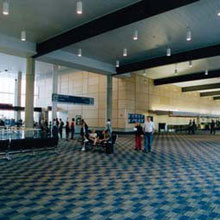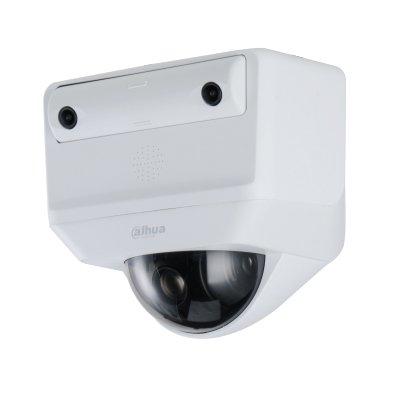 |
| The Johnson Controls security package features the Cardkey P2000R security management system |
The new terminal and its 12-gate concourse are a major component of an ambitious $200 million renovation and expansion project that began in April 2000. Connected to the existing terminal, the newly consolidated complex encompasses more than 450,000 square feet. When the airport decided to proceed with the project in the wake of 9/11, its design team looked to Johnson Controls, Inc. for a security solution that would meet current and future needs.
Bradley is New England’s second-largest commercial airport, serving as a link for southern New England to the national air transportation system. Because of its central location and ease of use, Bradley needed to expand its facilities just to accommodate its ever-increasing number of flights. In addition, after more than 60 years of technology upgrades, the original terminal contained systems that were redundant and independent of each other.
Johnson Controls worked directly with the construction manager, architect, mechanical and electrical engineers and a security consultant to provide critical low-voltage systems. The project team saw the value that Johnson Controls offered by taking sole responsibility for installation of these systems. “Our goal was to have a high-tech security system that would serve the current functional needs of our employees and future federal requirements,” says Barry Pallanck, airport administrator at Bradley. “Johnson Controls offered solutions that benefited travelers, airport personnel and our bottom line. As our security needs grow and industry requirements evolve, the new system can grow with us.”
Enhancing security through integration
After 9/11, the scope of the security project at Bradley changed from making necessary upgrades to exceeding even anticipated requirements. “Because of the tragedy, we had to pull back the bid and try to anticipate what the Federal Government was going to require. This resulted in a totally revised security package bid,” states Lisa Fazzino, airport security coordinator. “If you were to put the pre- and post-9/11 project bids next to each other, it wouldn’t even look like the same airport,” adds Gary Resnick, Glover Resnick Associates, security consulting engineer. “Even so, Bradley chose not to put construction on hold when many other airports did. Johnson Controls worked with us as a team to be proactive, and design a system that would be flexible and adaptive to new requirements issued by the Transportation Safety Administration (TSA).”
The revised security package features the Johnson Controls Cardkey® P2000R security management system. A new card access control system for approximately 5,000 airport employees, a CCTV surveillance system and digital video recording are integrated with the Cardkey system. The integration allows airport personnel to easily monitor and control all electronic security devices from stations throughout the airport. “The flexibility of the system
"Johnson Controls offered solutions that benefited travelers, airport personnel and our bottom line" |
puts useful, real-time information at the fingertips of the proper people. This is not only efficient and convenient, it also helps us keep the airport more secure,” says Fazzino. “This system makes it much easier to first recognise a breach, and then react immediately to avoid travel delays and potential emergencies,” adds Pallanck.
Key challenges for Glover Resnick were creating a system that was robust enough to handle the whole airport, which, in some cases, required very special software. In addition, the system needed to be fully redundant, since the airport could never be down. There were also running changes, such as the decision to add a fully equipped Command Center, which was not part of the original scope. It would require relocating the new systems without taking them offline. “Johnson Controls stepped up to the plate with a project plan and budget. They worked closely with us to get it done on time and on budget. It was a huge effort based on trust and a great example of what you can do when you all work together to a common goal,” says Resnick.
The new system also meets the unique security specifications of the Federal Inspection Station (FIS), which resides at the airport. When making upgrades to its security system, the FIS had a proprietary fiber optic network installed, connecting it with the airport’s security systems. This allows federal agents to maintain interior security for their building while enabling Bradley to maintain perimeter security of the airport’s property. To ensure the station’s privacy, Johnson Controls used partitioning and password protection which allows federal agents to override privacy measures, if necessary.
Integrated systems reduce cost and increase performance
Security systems were not the first integration to take place at Bradley’s new terminal. The airport’s mechanical consultants were familiar with Johnson Controls and understood the benefit of integrating multiple building systems and equipment into one management system. Johnson Controls participated early on in the design of the building management system.
 |
| Johnson was able to integrate Federal Inspection Station (FIS) facility with airport’s building management system |
The design included the installation of a Metasys® building management system and the installation and integration of the fire alarm system, lighting controls and variable frequency drives. As a result, airport personnel are able to monitor and control the systems from a central location. Johnson Controls also installed the airport’s audio paging system. “The integration allows us to be more efficient in the overall operations of the airport. Passengers and tenants of the airport also benefit because we can better react to seasonal temperature issues and provide a more comfortable environment,” states Pallanck. “Structuring this purchase in a way that all systems were bundled together lowered our first costs and allowed us to obtain the systems we wanted,” adds Fazzino.
Electrical usage is also integrated into Metasys, allowing Bradley Airport to track and monitor electrical usage for jet bridges and tenant areas. The airport uses tenant electrical reports to assure accurate tenant billing and jet bridge metering to confirm that systems are working properly. All of the information available through systems integration can be utilised by the airport to make smart decisions, increase performance and lower total cost of ownership.
Open systems connectivity allow building integration
Because of its open systems connectivity, Johnson Controls was able to integrate the Federal Inspection Station (FIS) facility on the airport grounds with the airport’s building management system. The airport is now able to communicate via open protocol with FIS. One-point access is available from any master workstation, allowing the user to see all information.


















